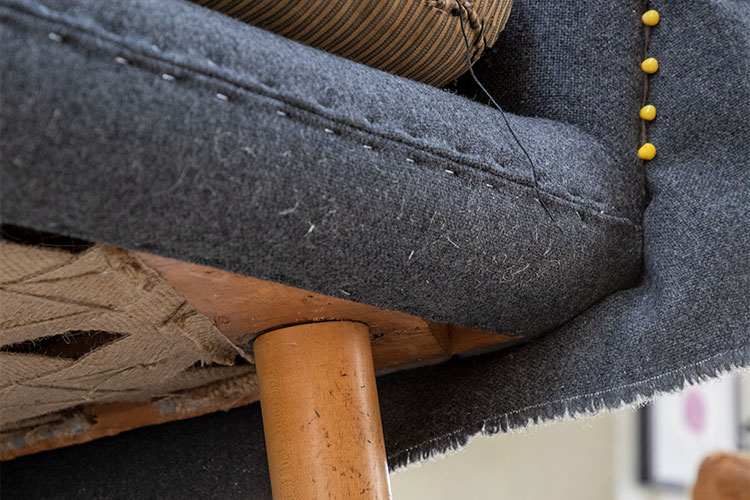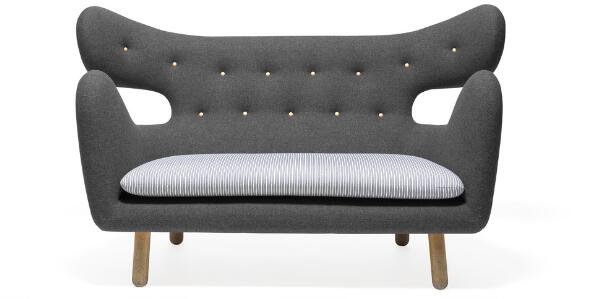The Lost Sofa of Finn Juhl
Danish homes often contain many design classics, but once in a while, a truly rare piece of furniture turns up which has sometimes even been considered lost. This has just happened at Bruun Rasmussen with an upholstered unique sofa and two accompanying chairs from Finn Juhl’s younger days as a designer. They are known as the “Elephant Furniture”.
With Finn Juhl's sofa and the two chairs, we are without a doubt dealing with Danish cultural heritage. We will present the furniture in separate lots at this year's final Live Auction in Copenhagen on 10 December, and with the sofa's estimate of DKK 1.5-2.5 million, we can also present our highest ever estimate on a Danish piece of design furniture from the 20th century.
When I saw Finn Juhl’s sofa, I could hardly believe my own eyes. I have worked with Danish design throughout my entire career, but this is the most interesting piece of furniture I have ever had in my care. The sofa is known only from photographs in literature, and everyone in the design world thought it had been lost for good. With this find, I now consider one of the great mysteries in Danish design history as being solved.
Peter KjelgaardHead of the Department for Design and Decorative Art at Bruun Rasmussen
The Making of a Sofa and Two Chairs
The year is 1939, and Finn Juhl has dropped out of his studies at the Royal Danish Academy of Fine Arts’ School of Architecture. Instead, he is working for the Danish architect Vilhelm Lauritzen on the construction of Radiohuset (The Radio House) on Frederiksberg. In his spare time, Juhl designs furniture for private customers, but this year he is also given the task of designing the interior for cabinetmaker Niels Vodder's stand at the Cabinetmakers' Guild Exhibition. The result is the unique sofa and two accompanying chairs, which we will soon present at auction.
Film: Watch design specialist Peter Kjelgaard tell the story behind Finn Juhl’s furniture
Too Much for the Contemporary Taste
At the time of its making, there were many who considered even the furniture of Kaare Klint as a bit too modern, so it should come as no surprise that this set of furniture by Finn Juhl was seen as controversial and provocative in its day. The shapes are sculptural and organic with references to modern art such as the playful style of Jean Arp.
In a review of the exhibition, the Danish newspaper Berlingske Aftenavis had the following comment: “The architect Finn Juhl has designed a very eccentric living room (…) The sofa is made in a strangely carved-out style. The peculiar furniture pieces are manufactured by Niels Vodder (…).”
Finn Juhl stood out among the other great furniture designers of his time. Originally, he wanted a career as an artist, but as a compromise with his father, Juhl decided to study architecture – without prior training as a carpenter for instance. Hans J. Wegner began his education as a cabinetmaker, and his designs were thus consciously or unconsciously influenced and strengthened by what was possible in terms of craftsmanship. Finn Juhl, on the other hand, did not have these built-in constraints in his approach to design. Instead, he approached his work from a more artistic angle. It was then up to the poor cabinetmaker Niels Vodder to turn Finn Juhl's ideas into reality.
Peter Kjelgaard

|
The Furniture Is Named After an Elephant
The sofa and the two chairs were originally bought directly from cabinetmaker Niels Vodder at the exhibition or shortly thereafter by the Danish painter and author Mogens Lorentzen. He was part of the progressive art scene in the interwar period and was among other things a writer for the culturally critical magazines "Klingen" (The Blade) and "Kritisk Revy" (Critical Review). In the broader Danish public, he is probably best known for his lyrics to the song “Juletræet med sin pynt” (The Christmas tree with its decorations) from 1939. The furniture has since then been in the ownership of Mogens Lorentzen's family.
After consigning the furniture to the auction house, the current owner told us that within the family the sofa and chairs have always been known as "The Elephant Furniture" due to their unique shape.
A Return to the Original LookAfter the furniture had been consigned to the auction house, we decided to bring the sofa and the two chairs back to their original look. Over time, the furniture had been reupholstered with new fabrics, and the wooden legs had been painted black. Since the old black and white photographs from the literature could only give us an impression of the original fabrics and colours to a limited extent, we were guessing at first. However, a pleasant discovery by our regular upholsterer made us wiser, because when he removed the upholstery of the furniture, remnants of the original fabric from 1939 appeared. So now we know exactly what kind of look Finn Juhl intended for the furniture – charcoal grey wool and blue and white striped fabric on the seat cushions. We have now recreated this look. |

|

|

|

For further information, please contact:
Peter Kjelgaard: +45 8818 1191 · pkj@bruun-rasmussen.dk
Amalie Hansen: +45 8818 1194 · amh@bruun-rasmussen.dk
Anna Berger Widenborg: +45 8818 1187 · awi@bruun-rasmussen.dk
Andreas Krabbe: +45 8818 1193 · ank@bruun-rasmussen.dk
Poul Svalgaard Henriksen: +45 8818 1132 · psh@bruun-rasmussen.dk
